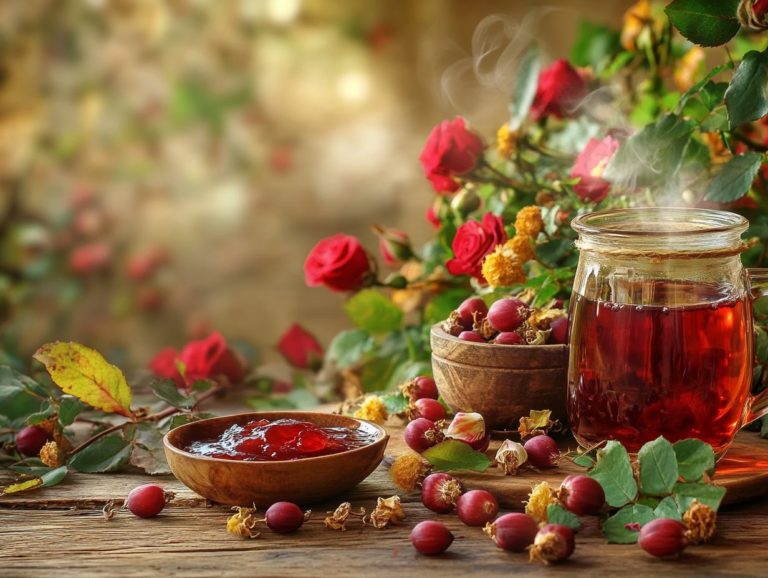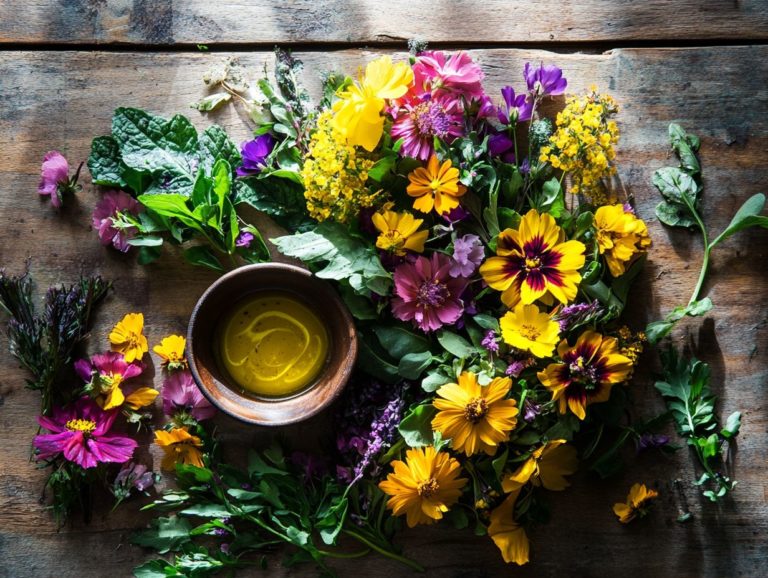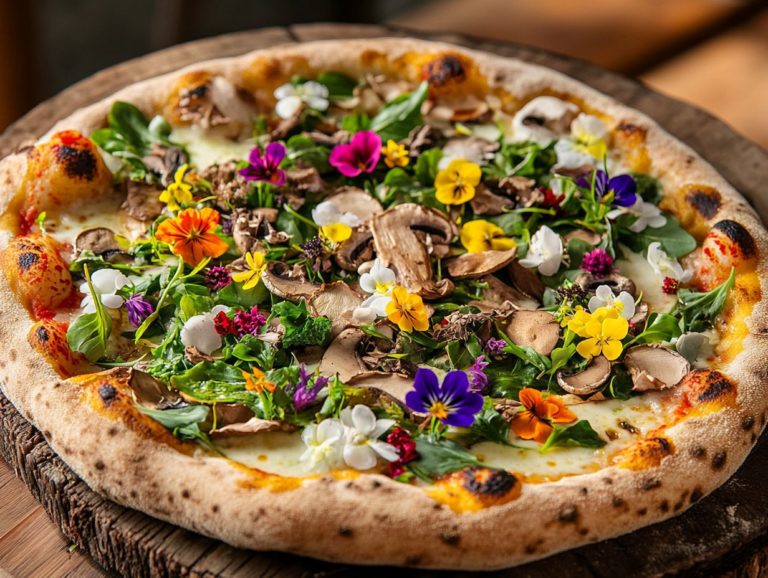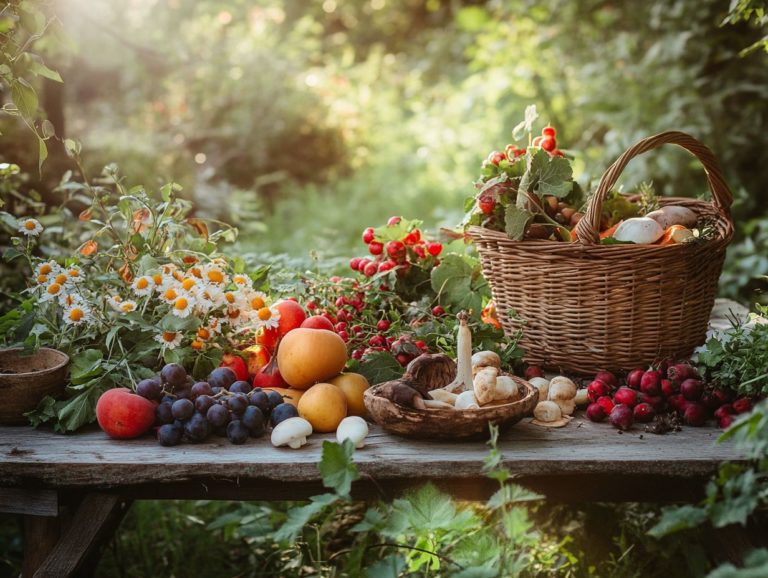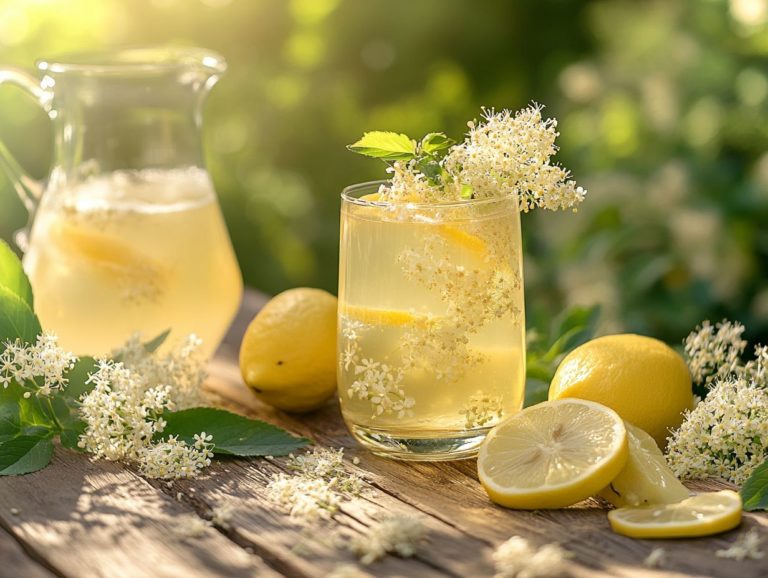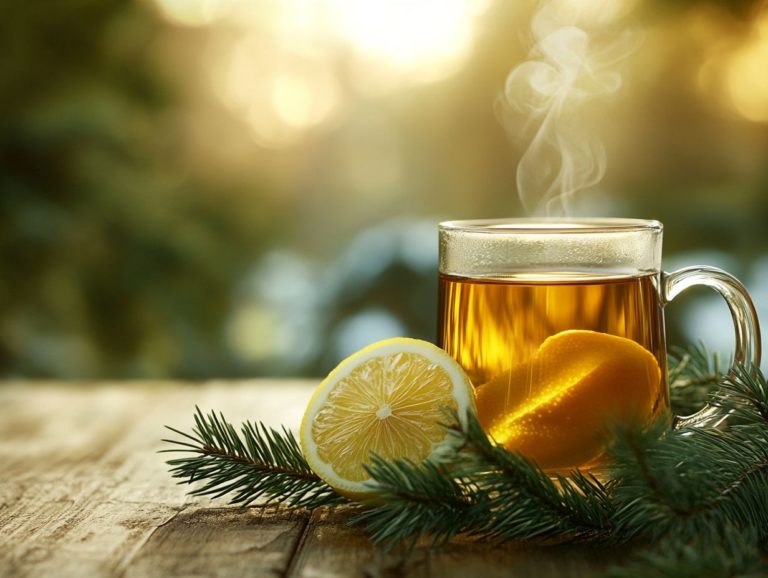5 Wild Edible Ingredients You Shouldn’t Miss
Discovering the world of wild edibles unveils a treasure trove of flavors and nutritional benefits waiting to be explored right in your backyard.
From the peppery bite of dandelion greens to the fragrant allure of elderflowers, you ll find five wild ingredients that are simply too good to overlook.
You ll delve into their nutritional perks, learn tips for safe identification and harvesting, discover mouthwatering preparation methods, and understand essential precautions to ensure your culinary adventure is both delightful and safe.
Are you ready to elevate your meals with nature s bounty? Let s dive in!
Contents
- Key Takeaways:
- 1. Dandelion Greens
- 2. Purslane
- 3. Stinging Nettles
- 4. Elderflowers
- 5. Wild Garlic
- Why Should You Incorporate Wild Edibles into Your Diet?
- What Are the Nutritional Benefits of These Wild Edibles?
- How Can You Safely Identify and Harvest Wild Edibles?
- What Are Some Delicious Ways to Prepare These Ingredients, and How Can You Utilize Wildcrafting Techniques?
- Are There Any Precautions to Take When Consuming Wild Edibles?
- What Are Some Other Wild Edibles to Try?
- Frequently Asked Questions
- What are the 5 wild edible ingredients you shouldn’t miss, including morel mushrooms and stinging nettles?
- Why shouldn’t I miss these 5 wild edible ingredients that contribute to local foods and community health?
- Where can I find these 5 wild edible ingredients?
- Are these 5 wild edible ingredients safe to eat?
- How can I incorporate these 5 wild edible ingredients into my meals?
- Can I substitute these 5 wild edible ingredients with store-bought alternatives?
Key Takeaways:
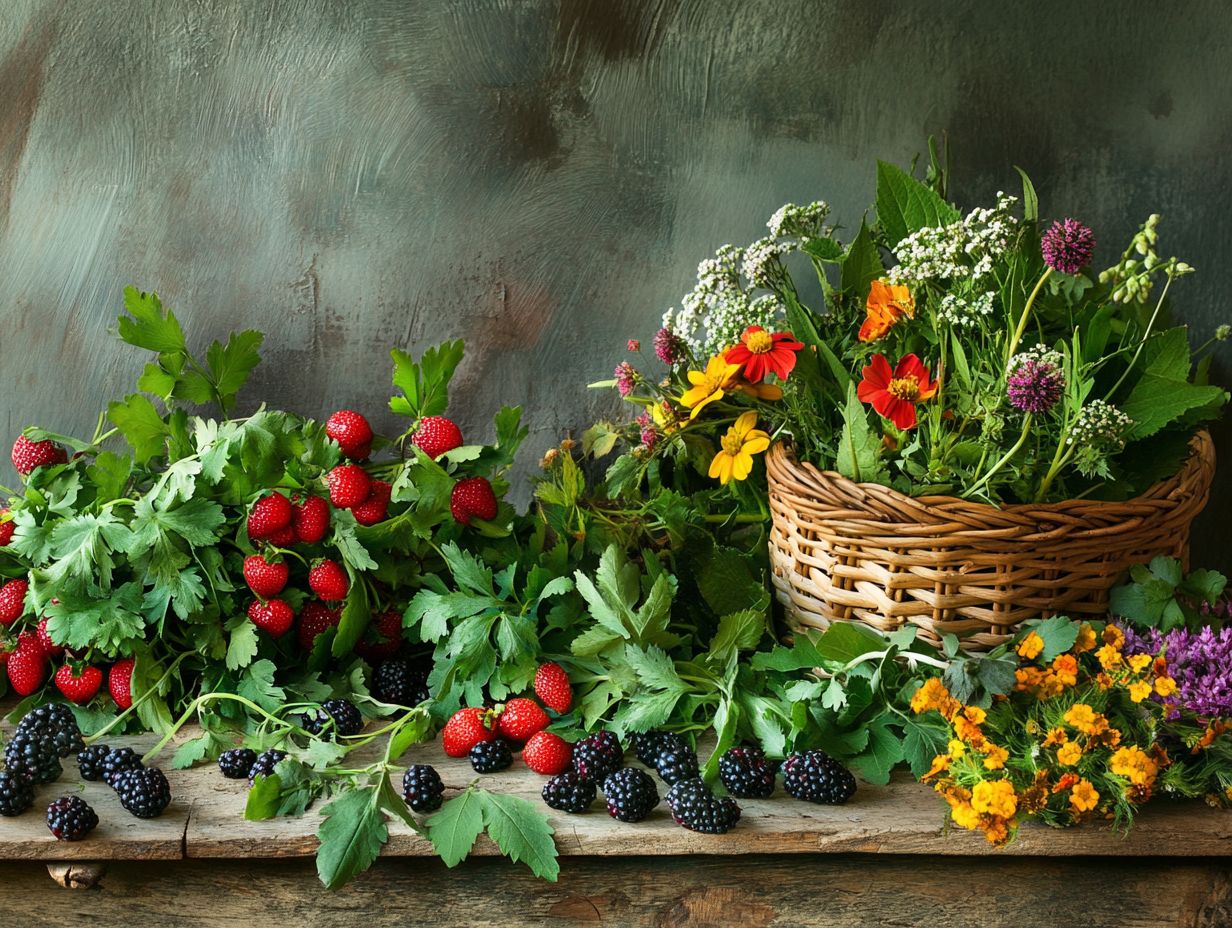
- Don’t miss out on the health benefits of wild edibles like dandelion greens, purslane, stinging nettles, elderflowers, and wild garlic.
- Learn to safely identify and harvest these ingredients to incorporate them into your diet in delicious ways.
- Exercise precautions and consult a professional when consuming wild edibles to ensure safety and avoid potential risks.
1. Dandelion Greens
Dandelion greens, also called Taraxacum officinale, are a treasure trove of nutrition. They are brimming with essential vitamins and minerals that can elevate your diet while supporting sustainability and biodiversity in local ecosystems.
These vibrant greens are particularly abundant in vitamins A and K. They make an excellent choice for anyone looking to enhance their overall health.
Incorporating dandelion greens into your meals is a breeze; toss them into salads for a peppery kick or blend them into smoothies for a nourishing boost. You can also steep them in hot water to create refreshing teas that unleash their detoxifying potential.
Just be sure to properly identify them, as some toxic look-alikes could pose a risk. With a little awareness and caution, you can safely indulge in the myriad health benefits that dandelion greens have to offer.
2. Purslane
Purslane, or Portulaca oleracea, is a succulent wild plant that offers much more than meets the eye. Not only does it serve as a rich source of omega-3 fatty acids (a type of healthy fat that is good for your heart) and antioxidants, but it also shines as a versatile ingredient in a variety of dishes.
This remarkable green is brimming with vitamins A, C, and E, along with important minerals like magnesium and potassium, making it a true nutritional powerhouse.
When you incorporate it into your cooking, you ll find it adds a delightful crunch and a slightly tangy flavor to fresh salads, elevating both texture and taste. Purslane can also enhance hearty soups or stir-fries, where it proudly retains its vibrant color and nutritional benefits, contributing to a well-rounded meal.
As with any foraged ingredient, remember to harvest purslane sustainably. This ensures that local ecosystems remain healthy and thriving while you enjoy its unique culinary attributes.
3. Stinging Nettles
Stinging nettles, or Urtica dioica, are often the unsung heroes of the wild plant world. They deliver a remarkable nutritional punch that you might not expect, especially when foraged with an understanding of proper identification techniques to avoid common poisonous plants.
Packed with an array of vitamins and minerals, these resilient herbs have been a staple in herbal medicine for centuries. Rich in vitamins A, C, K, and various B vitamins, along with important minerals like iron, calcium, magnesium, and potassium, stinging nettles offer an impressive nutrient profile.
But their benefits don t stop at nutrition; they ve also been traditionally used in herbal remedies for conditions like arthritis and allergic reactions.
Regarding harvesting these wild greens, a little caution goes a long way. Wearing gloves is a must, and it s best to trim the tops of the plants in spring when they re at their most tender. Once you ve collected them, a simple rinse and a bit of cooking will neutralize their stinging properties.
After that, you can dive into a world of delicious recipes, like nettle soup, pesto, or infused teas that truly showcase their unique flavor.
Ready to try wild edibles? Head outside and start your foraging adventure today!
4. Elderflowers
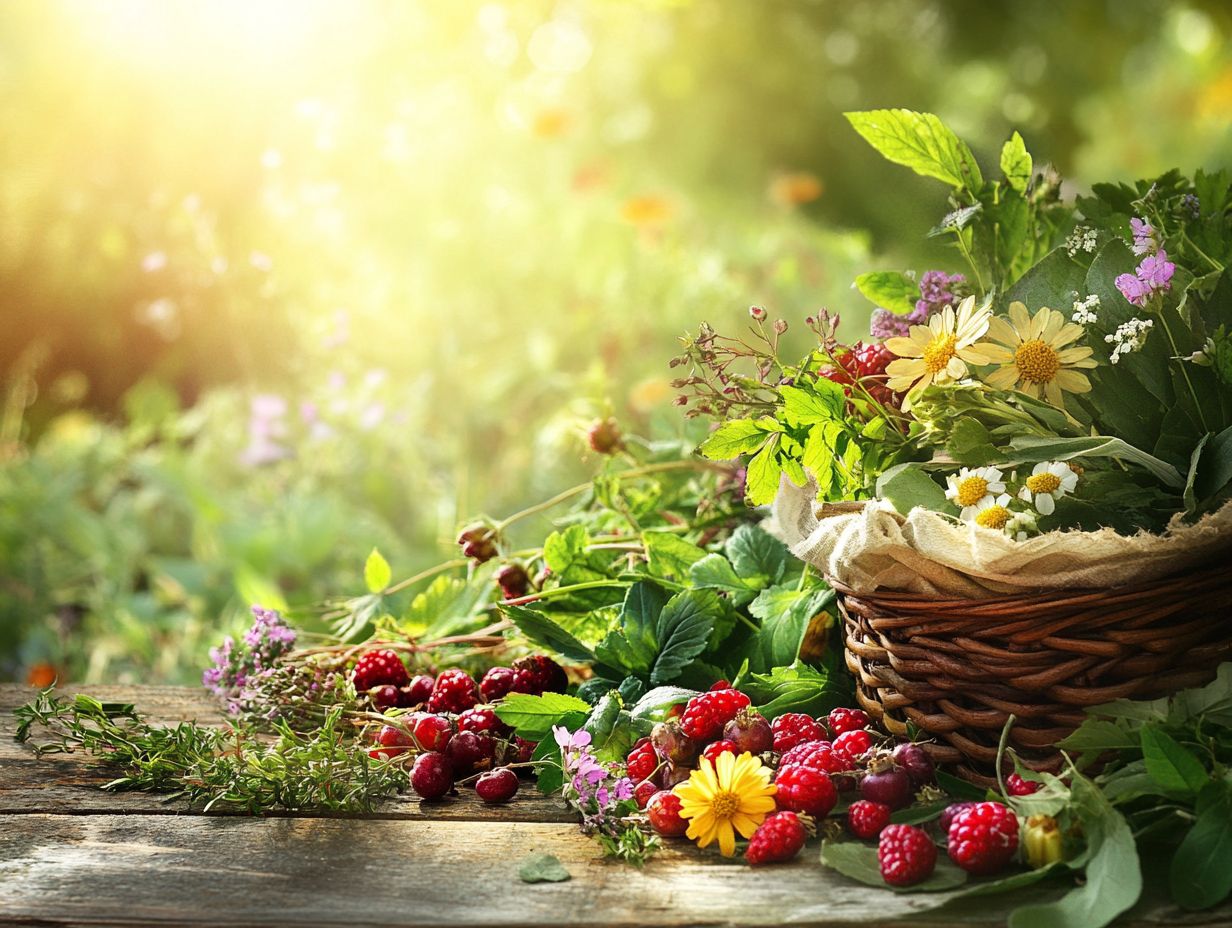
Elderflowers, sourced from the elegant Sambucus plant, are not just a treat for the senses. They boast impressive health benefits, making them highly coveted for herbal remedies and culinary masterpieces that highlight their versatility and nutritional contributions. Don’t miss out on the chance to experiment with elderflowers in your kitchen today!
These delicate blossoms can truly transform your cooking adventures! Imagine crafting delightful syrups that elevate beverages, turning a simple lemonade into a floral infusion or a cocktail into a stunning work of art. Their subtle sweetness is perfect for teas, which are enjoyable and known for soothing cold symptoms and encouraging relaxation.
When foraging for these blossoms, it’s essential to identify them accurately. They can easily be mistaken for toxic plants, which are plants that can make you sick, like water hemlock. By equipping yourself with the knowledge to recognize the right species, you’ll ensure a safe and rewarding harvest.
This allows you to fully embrace the many ways elderflowers can enhance your culinary adventures and contribute to your overall well-being through sustainable practices.
5. Wild Garlic
Wild garlic, known scientifically as Allium vineale, is a flavorful and aromatic wild edible that elevates your dishes with its unique taste. It also brings a wealth of health benefits, including antibacterial properties and a rich nutrient profile that aligns with other nutrient-rich options available in the wilderness.
This vibrant green herb thrives in damp woodlands and can be a delightful addition to your culinary repertoire. If you’re looking to enhance your cooking, consider blending it into a creamy pesto; its bold flavor pairs beautifully with nuts and cheese.
Alternatively, you can incorporate it into sumptuous soups, creating a comforting, earthy base that warms the soul. The health benefits of wild garlic extend far beyond flavor; it s packed with vitamins A and C, which contribute to your overall wellness.
When foraging, it’s crucial to identify it correctly by its long, lance-shaped leaves and unmistakable garlicky aroma. This helps you harvest responsibly, so future generations can enjoy wild garlic too.
Why Should You Incorporate Wild Edibles into Your Diet?
Incorporating wild edibles into your diet offers not just a treasure trove of nutritional benefits think essential vitamins, minerals, and unique flavors but also fosters sustainability and biodiversity. This practice allows you to connect with your local ecosystems in a truly meaningful way.
These nutrient-dense options often outshine conventional grocery store produce. Conventional produce can fall short in freshness and vigor due to lengthy transportation times and industrial farming methods. By choosing wild edibles, you indulge in a diverse array of tastes while accessing a wealth of health-boosting compounds that can elevate your overall well-being.
Foraging cultivates a deeper appreciation for nature, encouraging sustainable practices that help shrink your carbon footprint. Supporting local foods promotes ecological balance, preserving vital habitats for wildlife and contributing to a thriving biosphere while nourishing your body and supporting community gardens.
What Are the Nutritional Benefits of These Wild Edibles?
Wild edibles are a treasure trove of nutrients, providing a rich source of vitamins, minerals, and antioxidants that can significantly enhance your overall health and well-being when incorporated into a balanced diet.
These remarkable plants are packed with vitamin A, essential for maintaining healthy vision and skin. The high vitamin C content boosts your immune system and aids in wound healing. Don t overlook the impressive dose of vitamin K they offer, which is crucial for blood clotting and bone health.
Wild edibles also provide vital minerals such as iron, which supports energy production, and calcium, essential for strong bones and teeth. With their powerful antioxidant properties, these natural foods help combat oxidative stress in your body, potentially reducing the risk of chronic diseases and promoting longevity.
How Can You Safely Identify and Harvest Wild Edibles?
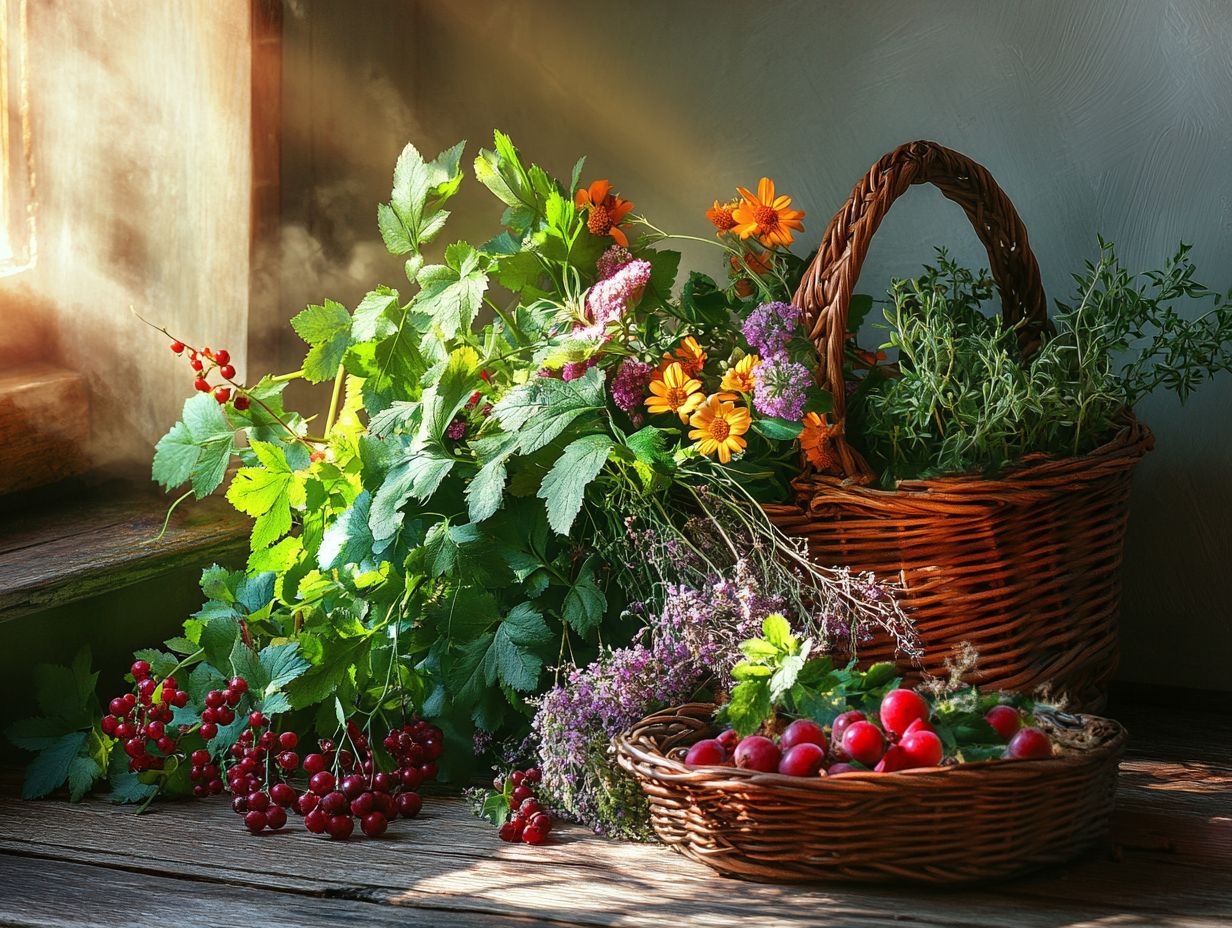
Safety is paramount when foraging for wild edibles. Mastering proper identification techniques and understanding toxic plants are essential skills that will elevate your foraging experience.
Enhancing these skills can significantly benefit from utilizing field guides or smartphone apps designed for plant identification. These resources allow you to compare your findings with detailed images and descriptions, ensuring you make informed choices.
The importance of being familiar with common poisonous plants cannot be overstated, as misidentification could pose serious health risks. Therefore, keep a reference guide close at hand while you explore.
To cultivate a sustainable foraging practice, always take only what is necessary, respect local ecosystems, and avoid overharvesting. Leave ample plants to thrive and reproduce. This mindful approach benefits the environment and guarantees future foraging opportunities.
What Are Some Delicious Ways to Prepare These Ingredients, and How Can You Utilize Wildcrafting Techniques?
The culinary potential of wild edibles is truly remarkable. For instance, 5 wild plants to forage this winter offer a multitude of delicious recipes that celebrate their unique flavors while maximizing their nutritional benefits in everyday cooking.
These vibrant ingredients can elevate simple dishes into extraordinary gastronomic experiences. For savory delights, toss dandelion greens into a refreshing salad or saut ramps to create a rich, flavorful base for pasta.
Sweet options are plentiful; wild berries can be transformed into delectable jams or infused into baked goods like muffins and pies. Employing various cooking techniques such as steaming, foraging, or quick pickling can help preserve delicate nutrients while enhancing the natural sweetness or earthiness of these ingredients.
With endless possibilities, wild edibles become a delightful addition to any culinary adventure you embark on, especially when you try 5 wild edible recipes for outdoor cooking.
Are There Any Precautions to Take When Consuming Wild Edibles?
While wild edibles present a wealth of health benefits, be careful and enjoy the thrill of foraging! To maximize your experience, consider learning about the top 5 edible fungi for sustainable foraging. It’s essential to avoid potential pitfalls, such as allergic reactions or mistaking toxic plants for their safe counterparts.
As a forager, you must do careful research and accurately identify any wild food before indulging. Familiarity with the local flora is crucial; misidentifying a plant could lead to serious consequences.
Being aware of your surroundings is equally important. Pollution in certain areas can compromise otherwise safe edibles. For example, plants growing near industrial sites or busy roads might absorb harmful substances, rendering them unsafe for consumption.
In the end, a blend of caution and knowledge is your best bet to ensure that foraging remains both a safe and rewarding adventure.
What Are Some Other Wild Edibles to Try?
Exploring the world of wild edibles reveals a treasure trove of delicious options that extend far beyond the usual favorites. For example, consider trying 5 wild edible snacks for your next hike. You’re stepping into a realm that showcases the incredible biodiversity in your natural surroundings while promoting sustainable foraging practices.
Among these hidden gems, you’ll encounter plantain, burdock, and chicory, each boasting unique flavors and nutritional benefits. Plantain, often lurking in backyards, is a powerhouse of vitamins A, C, and K, making it a delightful addition to salads or a tasty cooked dish reminiscent of spinach.
Burdock, with its earthy flavor, is a root vegetable that offers high fiber content and antioxidants perfect for enriching soups or stir-fries. Chicory, on the other hand, brings a slightly bitter note to your salads and is rich in inulin, a type of fiber that helps with digestion.
By embracing these wild edibles, you can indulge in nature’s pantry while committing to ethical foraging practices that ensure these natural resources remain abundant for generations to come. For more details, check out winter foraging: 5 edibles to keep you nourished.
Frequently Asked Questions
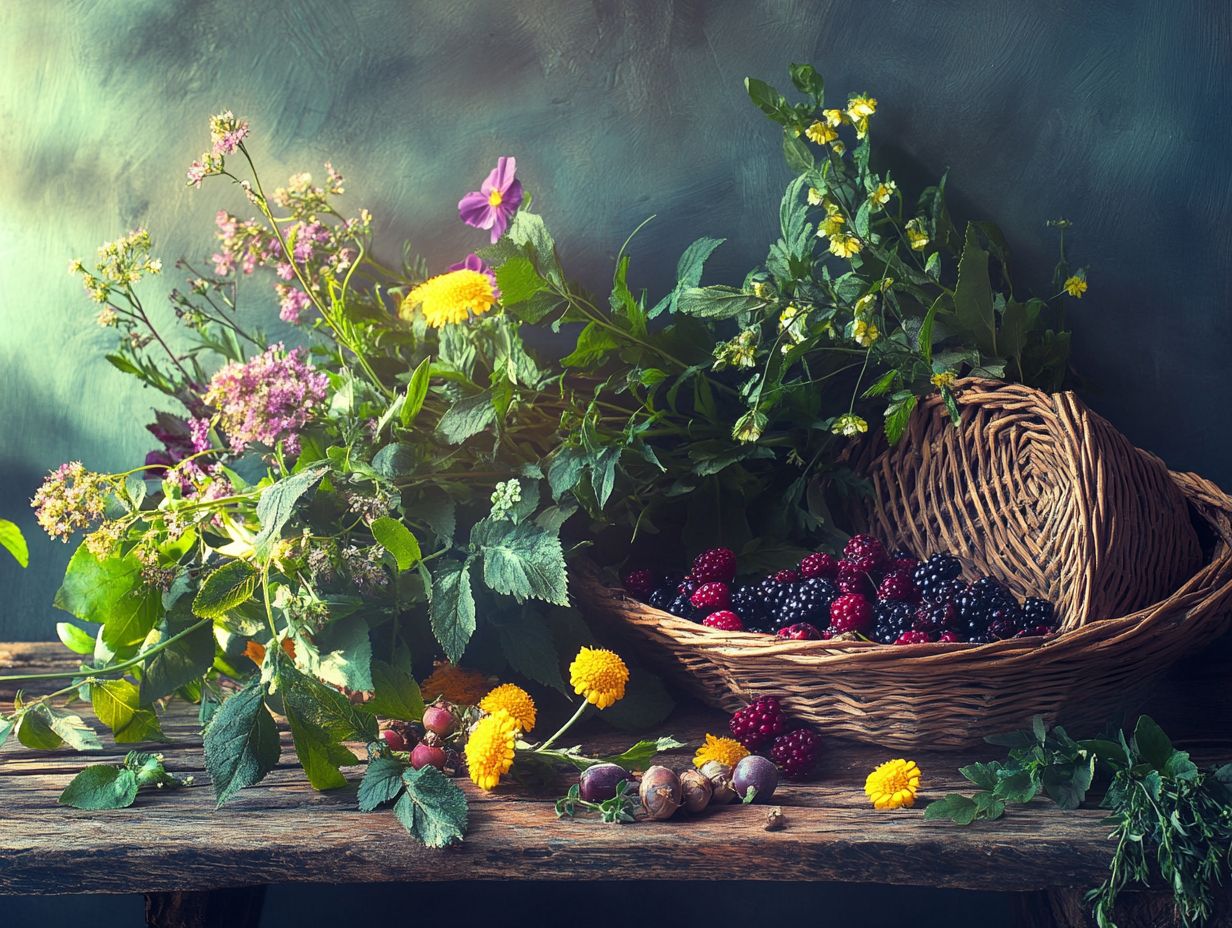
Start foraging today to unlock the amazing flavors nature has to offer!
What are the 5 wild edible ingredients you shouldn’t miss, including morel mushrooms and stinging nettles?
The 5 wild edible ingredients you shouldn’t miss are ramps, fiddleheads, morel mushrooms, stinging nettles, and beach plums.
Why shouldn’t I miss these 5 wild edible ingredients that contribute to local foods and community health?
These ingredients are delicious. They offer health benefits and unique flavors that you won’t find in grocery stores.
Where can I find these 5 wild edible ingredients?
You can find them in the wild, typically in forests, meadows, and along the coast. You must know how to identify them before you forage.
Are these 5 wild edible ingredients safe to eat?
Yes, they are safe to eat as long as you properly identify them. Always consult a local expert or guide before consuming wild edibles.
How can I incorporate these 5 wild edible ingredients into my meals?
You can use these ingredients in various dishes, such as soups, stir-fries, salads, and even desserts. You can preserve them by pickling, drying, or freezing for later.
Can I substitute these 5 wild edible ingredients with store-bought alternatives?
You can substitute these ingredients. However, the unique flavors and health benefits of common wild edibles found in your backyard cannot be replicated.
Discover the amazing flavors of these wild edibles! Foraging for them can be a fun adventure.

